
Houstonia caerulea, commonly known as azure bluet, Quaker ladies, or bluets, is a perennial species in the family Rubiaceae. It is native to eastern Canada and the eastern United States. It is found in a variety of habitats such as cliffs, alpine zones, forests, meadows and shores of rivers or lakes.

Houstonia (bluet) is a genus of plants in the family Rubiaceae. Many species were formerly classified, along with other genera since segregated elsewhere, in a more inclusive genus Hedyotis.
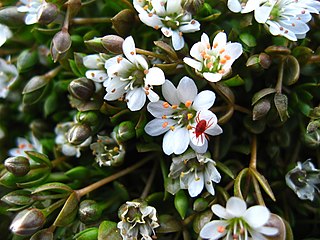
Stellaria humifusa, the saltmarsh starwort, is plant native to northern North America and Eurasia.
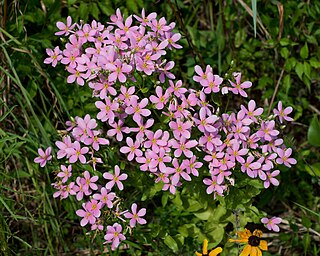
Sabatia, the rose gentians, is a genus of about 20 species of flowering plants in the family Gentianaceae, native to eastern and central North America, Central America, and the Caribbean.

Houstonia longifolia, commonly known as long-leaved bluet or longleaf summer bluet, is a perennial plant in the family Rubiaceae. It can be found throughout most of the Eastern United States and Canada. It has been reported from every state east of the Mississippi River except Delaware, plus North Dakota, Minnesota, Missouri, Arkansas and Oklahoma, with isolated populations in Kansas and Texas. Also, all Canadian provinces from Quebec to Alberta. It prefers upland woods in poor, dry, often sandy soil.

Ribes aureum, known by the common names golden currant, clove currant, pruterberry and buffalo currant, is a species of flowering plant in the genus Ribes native to North America.
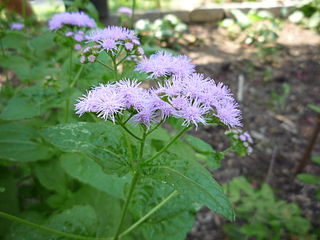
Conoclinium, the mistflowers, is a genus of four species of herbaceous perennial flowering plants, native to North America. They are 0.5 to 2 metres tall, and have blue to purple or violet flowers.

Opuntia humifusa, commonly known as the devil's-tongue, eastern prickly pear or Indian fig, is a cactus of the genus Opuntia present in parts of the eastern United States and northeastern Mexico.

Houstonia pusilla is a plant in the family Rubiaceae native to the United States and common in the southeastern and central parts of the country, from Texas to Florida north to Long Island and South Dakota, plus an isolated population in Pima County, Arizona.
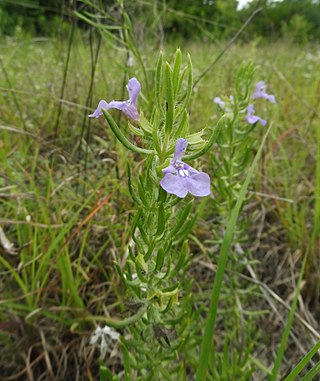
Salvia texana, commonly called Texas sage, is a species of flowering plant in the mint family (Lamiaceae). It is native to North America, where it is found in northern Mexico, and in the U.S. states of Texas and New Mexico. Its natural habitat is dry areas on limestone soils, in prairies or over rock outcrops.
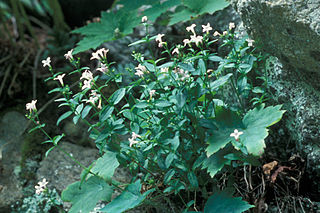
Houstonia purpurea is a species of flowering plant in the coffee family known by the common names Venus's pride, woodland bluet, and purple bluet. It is native to the eastern United States from eastern Texas and Oklahoma east to Florida and Pennsylvania, with scattered populations in Nebraska, Iowa, Michigan, New York State and New England.
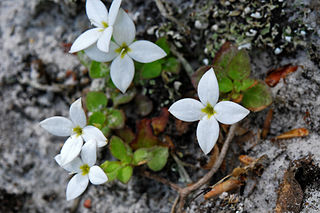
Houstonia procumbens, the roundleaf bluet, is a perennial species in the family Rubiaceae. It is native to the southeastern United States: Louisiana, Mississippi, Alabama, Georgia, Florida and South Carolina. Its native habitats include disturbed sites, and moist, open, sandy areas. Flowers bloom March to October.
Houstonia ouachitana, the Ouachita bluet, is a species of plants in the coffee family. It is endemic to the Ouachita Mountains of Arkansas and Oklahoma. It is an herb up to 20 cm tall, with lanceloate basal leaves and narrowly linear cauline leaves.
Houstonia acerosa, the New Mexico bluet or needleleaf bluet, is a plant species native to Chihuahua, Coahuila, Nuevo León, Tamaulipas, San Luis Potosí, Texas and New Mexico.

Houstonia micrantha, the southern bluet, is a plant species in the coffee family.
Houstonia parviflora, the few-flowered bluet or Greenman's bluet, is a plant species in the Rubiaceae, found only in south-central Texas.

Houstonia serpyllifolia, commonly called thymeleaf bluet, creeping bluet, mountain bluet, Appalachian bluet or Michaux's bluets is a species of plant in the coffee family (Rubiaceae). It is native to the eastern United States, where it is found in the central and southern Appalachian Mountains. It has been documented in the states of Pennsylvania, Maryland, West Virginia, western Virginia, North Carolina, South Carolina, Kentucky, Tennessee, Ohio, and northeastern Georgia.
Smilax walteri, common names coral greenbrier, red-berried greenbrier, or red-berried bamboo, is a North American species of plant found only in the United States. It is native to coastal plains in the south-central, southeastern, and east-central parts of the country, from eastern Texas to New Jersey.

Senega alba, commonly called white milkwort, is a species of flowering plant in the milkwort family (Polygalaceae).

Ammoselinum butleria, commonly called the Butler's sandparsley, is a species of flowering plant in the carrot family (Apiaceae). It is native to North America, where it is found primarily in the South Central United States. It is most often found in disturbed sandy areas, including lawns. Its range has expanded eastward in recent times, leading some authorities to consider populations east of the Mississippi River to be non-native.















